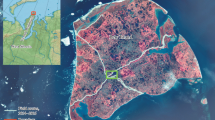Abstract
Mars probes send back to Earth enormous amount of data. Automating the analysis of this data and its interpretation represents a challenging test of significant benefit to the domain of planetary science. In this study, we propose combining terrain segmentation and classification to interpret Martian topography data and to identify constituent landforms of the Martian landscape. Our approach uses unsupervised segmentation to divide a landscape into a number of spatially extended but topographically homogeneous objects. Each object is assigned a 12 dimensional feature vector consisting of terrain attributes and neighborhood properties. The objects are classified, based on their feature vectors, into predetermined landform classes. We have applied our technique to the Tisia Valles test site on Mars. Support Vector Machines produced the most accurate results (84.6% mean accuracy) in the classification of topographic objects. An immediate application of our algorithm lies in the automatic detection and characterization of craters on Mars.
Access this chapter
Tax calculation will be finalised at checkout
Purchases are for personal use only
Preview
Unable to display preview. Download preview PDF.
Similar content being viewed by others
References
Adams, R., Bischof, L.: Seeded Region Growing. IEEE Trans. Pattern Analysis and Machine Intelligence 16(6), 641–647 (1994)
Baatz, M., Schäpe, A.: Multiresolution Segmentation - An Optimization Approach for High Quality Multi-Scale Image Segmentation. In: Strobl, J., et al. (eds.) Angewandte Geographische Informationsverarbeitung, vol. XII, pp. 12–23. Wichmann, Heidelberg (2000)
Barlow, N.G.: Crater Size-Distributions and a Revised Martian Relative Chronology. Icarus 75(2), 285–305 (1988)
Belongie, S., Carson, C., Greenspan, H., Malik, J.: Color and Texture-based Image Segmentation Using EM and its Application to Content-based Image Retrieval. In: Proc. of Sixth IEEE Int. Conf. Comp. Vision, pp. 675–682 (1998)
Bentley, J.L.: Multidimensional Binary Search Trees Used for Associative Searching. Communications of ACM 18(9), 509–517 (1975)
Breiman, L.: Bagging Predictors. Machine Learning 24, 123–140 (1996)
Bue, B.D., Stepinski, T.F.: Automated classification of Landforms on Mars. Computers & Geoscience 32(5), 604–614 (2006)
Burl, M.C., Stough, T., Colwell, W., Bierhaus, E.B., Merline, W.J., Chapman, C.: Automated Detection of Craters and Other Geological Features. In: Proc. Int. Symposium on Artificial Intelligence, Robotics and Automation for Space, Montreal, Canada (2001)
Chen, Q., Zhou, C., Luo, J., Ming, D.: Fast Segmentation of High-Resolution Satellite Images Using Watershed Transform Combined with an Efficient Region Merging Approach. In: Klette, R., Žunić, J. (eds.) IWCIA 2004. LNCS, vol. 3322, pp. 621–630. Springer, Heidelberg (2004)
Cintala, M.J., Head, J.W., Mutch, T.A.: Martian Crater Depth/Diameter Relationship: Comparison with the Moon and Mercury. In: Proc. Lunar Sci. Conf., vol. 7, pp. 3375–3587 (1976)
Cintala, M.J., Mouginis-Mark, P.J.: Martian Fresh Crater Depth: More Evidence for Subsurface Volatiles. Geophys. Res. Lett. 7, 329–332 (1980)
Cooper, G.F., Herskovits, E.: A Bayesian Method for the Induction of Probabilistic Networks from Data. Machine Learning 9(4), 309–347 (1992)
Deng, Y., Manjunath, B.S.: Unsupervised Segmentation of Color-Texture Regions in Images and Video. IEEE Trans. Pattern Analysis and Machine Intelligence 23(8), 800–810 (2001)
Honda, R., Iijima, Y., Konishi, O.: Mining of Topographic Feature from Heterogeneous Imagery and Its Application to Lunar Craters. In: Arikawa, S., Shinohara, A. (eds.) Progress in Discovery Science. LNCS, vol. 2281, p. 395. Springer, Heidelberg (2002)
Jing, F., Li, M.J., Zhang, H.J., Zhang, B.: Unsupervised Image Segmentation Using Local Homogeneity Analysis. In: Proc. IEEE International Symposium on Circuits and Systems, pp. II-456–II-459 (2003)
Kim, J.R., Muller, J.-P., van Gasselt, S., Morley, J.G., Neukum, G.: The HRSC Col Team: Automated Crater Detection, A New Tool for Mars Cartography and Chronology. Photogrammetric Engineering & Remote Sensing 71(10), 1205–1217 (2005)
Kohonen, T.: Self-Organizing Maps. Springer, Heidelberg (1995)
Koperski, K., Han, J., Stefanovic, N.: An Efficient two-Step Method for Classification of Spatial Data. In: Proc. Eight Symp. Spatial Data Handling, pp. 45–55 (1998)
Molloy, I., Stepinski, T.F.: Automatic Mapping of Valley Networks on Mars. Computers & Geoscience (submitted, 2006)
Mouginis-Mark, P.J., Garbeil, H., Boyce, J.M., Ui, C.S.E., Baloga, S.M.: Geometry of Martian Impact Craters: First Results from an Iterative Software Package. J. Geophys. Res. 109, E08996 (2004)
Nock, R., Nielsen, F.: Stochastic Region Merging. IEEE Trans. Pattern Analysis and Machine Intelligence 26(11), 1452–1458 (2004)
Rodionova, J.F., Dekchtyareva, K.I., Khramchikhin, A.A., Michael, G.G., Ajukov, S.V., Pugacheva, S.G., Shevchenko, V.V.: Morphological Catalogue of the Craters of Mars. ESA-ESTEC (2000)
Smith, D., Neumann, G., Arvidson, R.E., Guinness, E.A., Slavney, S.: Mars Global Surveyor Laser Altimeter Mission Experiment Gridded Data Record. NASA Planetary Data System, MGS-M-MOLA-5-MEGDR-L3-V1.0 (2003)
Soderblom, L.A., Condit, C.D., West, R.A., Herman, B.M., Kreidler, T.J.: Martian Planetwide Crater Distributions: Implications for Geologic History and Surface Processes. Icarus 22, 239–263 (1974)
Stepinski, T.F., Vilalta, R.: Digital Topography Models for Martian surfaces. IEEE Geoscience and Remote Sensing Letters 2(3), 260–264 (2005)
Vincent, L., Soille, P.: Watersheds in Digital Spaces: An Efficient Algorithm Based on Immersion Simulations. IEEE Trans. Pattern Analysis and Machine Intelligence 13(6), 583–598 (1991)
Vinogradova, T., Burl, M., Mjosness, E.: Training of a Crater Detection Algorithm for Mars Crater Imagery. In: Aerospace Conference Proc. 2002, pp. 7–3211. IEEE, Los Alamitos (2002)
Wetzler, P.G., Enke, B., Merline, W.J., Chapman, C.R., Burl, M.C.: Learning to Detect Small Impact Craters. In: Seventh IEEE Workshops on Computer Vision (WACV/MOTION 2005), vol. 1, pp. 178–184 (2005)
Witten, I.H., Frank, E.: Data Mining: Practical Machine Learning Tools and Techniques, 2nd edn. Morgan Kaufmann, San Francisco (2005)
Author information
Authors and Affiliations
Editor information
Editors and Affiliations
Rights and permissions
Copyright information
© 2006 Springer-Verlag Berlin Heidelberg
About this paper
Cite this paper
Stepinski, T.F., Ghosh, S., Vilalta, R. (2006). Automatic Recognition of Landforms on Mars Using Terrain Segmentation and Classification. In: Todorovski, L., Lavrač, N., Jantke, K.P. (eds) Discovery Science. DS 2006. Lecture Notes in Computer Science(), vol 4265. Springer, Berlin, Heidelberg. https://doi.org/10.1007/11893318_26
Download citation
DOI: https://doi.org/10.1007/11893318_26
Publisher Name: Springer, Berlin, Heidelberg
Print ISBN: 978-3-540-46491-4
Online ISBN: 978-3-540-46493-8
eBook Packages: Computer ScienceComputer Science (R0)




